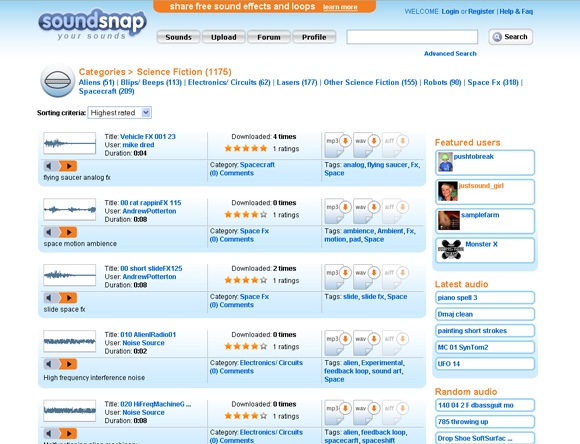
People can be annoying. I imagine some of you really don’t like people much, and I hear you. If you do like people, though, and whole communities of them, you may have noticed that countless websites are now marketed around the ability to interact with people and share stuff with them. Thankfully, some of these communities have actual, practical uses, like sharing free sound samples.
Soundsnap.com is a new project that promises to be the “YouTube of sounds.” I assume this means sounds of a skateboarding pup will become wildly popular, “lonely girl” rebecca will turn out to be fictional, and the whole thing will get bought out by Google.
Okay, scratch that. The real point is that this library of 30,000 sounds and growing will provide another resource for finding samples. Creator Tasos Frantzolas is a sound designer and producer from Greece who says he wanted just such a service for himself. The angle here is “high-quality” sounds, categorized by use, with everything from music loops to sound effects. That contrasts with the more free-form efforts we’ve seen elsewhere.
Soundsnap does let you use the sounds freely in any project, with no cost to you, and it appears to have an early edge in quality sounds. However, it contrasts with projects like the Freesound Project (for sound samples) and ccMixter (for full-length, remixable tracks) in that the license is not Creative Commons. Uploaders “retain all ownership rights to submissions while granting SoundSnap a worldwide, non-exclusive, royalty-free, transferable sublicense.”

Someone with legal experience with Creative Commons might be able to comment on other advantages or disadvantages, but I could see the services coexisting. To the end user, the bottom line is they can share sounds they’ve worked on for use by others, while gaining access to new resources for free sounds. The major difference here may be the different tone of these sites, and distinct feature sets. Having a growing number of free sample sites could help the idea gain popularity.
The Freesound Project (A “collaborative database” of Creative Commons-licensed sounds)
ccMixter (A CC-licensed database of full songs and remixes)
There are also additional Creative Commons and public domain sound libraries, albeit without the community features of these other sites. Some examples from The Internet Archive:
Have a listen and let us know what you think.